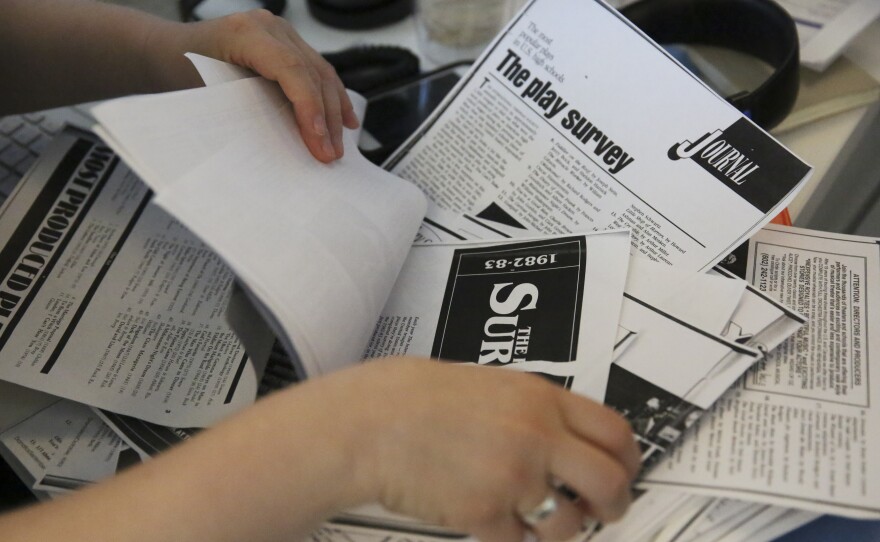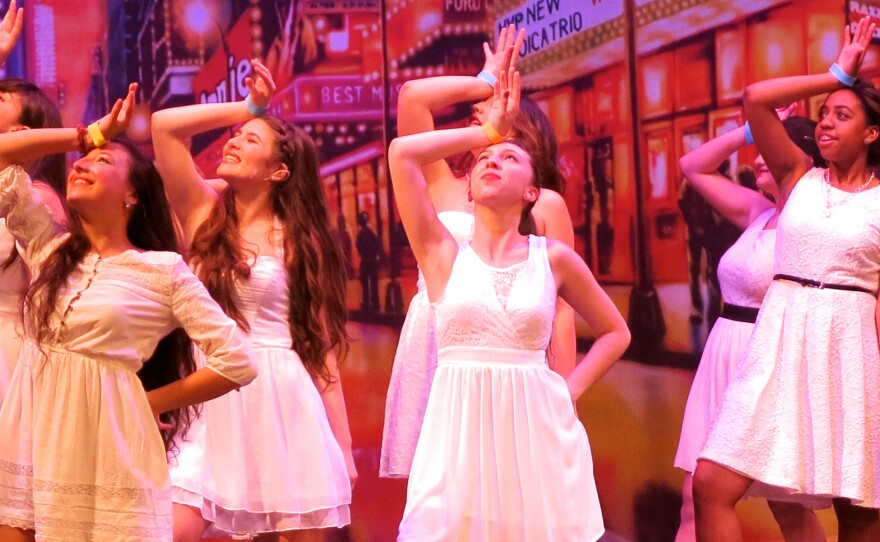
True, I never basked in the glow of the high school stage. But I have fond memories of working behind the scenes, as stage crew. Dressed in black, I rushed the bed onstage for Tevye's dream sequence in Fiddler on the Roof.
I've also spoken with many people who weren't involved in theater at all but can still — for some reason — remember the shows their schools performed.
There's just something about the high school stage.
Recently, my mom told me that she and her best friend, Chris, had been reminiscing about McDowell High School's performance of South Pacific in 1965. She wasn't in the show but can still name friends and classmates who were.
All of this got me wondering: "Were other high schools performing the same shows that year?"
As it turns out, the answer is in Dramatics — a monthly magazine for theater educators. It's been publishing an annual ranking of the most popular high school plays and musicals since 1938.
Until now, no one has ever compiled the data. It wasn't even digitized. Six months ago, Don Corathers, the magazine's editor, began digging through the archives for hard copies of each original issue — nearly 100 pages in all.
Last winter, he wrote to explain a delay: "What's taking so long, other than the distraction of publishing a magazine, is that we have to locate the articles in bound copies in order to scan them."
Eventually, he found them all, made copies — a huge stack — and mailed them to the NPR Ed team here in Washington, D.C.
The Plays
Over the last 76 years, the most popular plays have consistently been Our Town and You Can't Take It With You, according to our analysis.
Why, you ask?
"Most high school teachers need a big cast, lots of female roles, and something that won't scare your grandma," says Corathers, who's been with Dramatics since 1979.
For both plays: check, check and check.
You Can't Take It With You has been performed so often that it led to this cheeky, 2008 photo caption: "You Can't Take It With You — but evidently you can perform it forever."
Indeed. Even into the 1980s it was the most-produced high school play in America, topping the list every year that decade but one, 1982, when it fell just short of Our Town.
Oldies But Goodies
One thing is obvious: These plays are old.
"The consciousness of school theater seems to be stuck in about 1954" — so says a 1992 issue of Dramatics. And in 2007: "Our straight plays are getting older. A lot older."
"In the 60s the language and subject matter changed," explains Corathers. "It was also excruciatingly expensive to put on a play, so new plays had small casts. People were just not writing plays that could be produced in high schools."
In 1976 — noticing that schools were eschewing new for old — the magazine's editors wrote an op-ed. They urged schools to produce more contemporary works.
"Only four plays are fresh to the list this year," editor Thomas Barker bemoaned. "Four of sixty-eight."
Barker's argument: Theater should reflect society, and society had changed.
A year later — with little movement in the rankings — the editors backed down:
"No more going out on limbs, no more coaxing, no more labored analysis," they wrote. "We will let the charts speak for themselves."
And Corathers believes that, even today, those old staples of the stage are still relevant. Good theater is good theater, he says, no matter when it was written.
Looking at the nearly 80 years of data, another trend stands out:
More often than not, popular plays stayed popular over time.
Corathers offers this explanation: School theater directors and educators use the magazine's survey to find ideas for next year. The rankings make it easy for a theater director to sell the school's principal on a safe slate.
In short, says Corathers: "The list becomes self perpetuating."
Oh, The Musicals!
Musicals didn't really make waves in rankings until 1960. But Bye Bye Birdie and Oklahoma! have been the most popular titles ever since.
In recent years, musical tastes appear to have shifted, with more contemporary titles moving up the list.
Disney Theatrical plays a substantial role. "Live theater is adapting animated films," says Corathers, pointing to Beauty and the Beast. "They are instantly family-friendly. They are familiar stories with great songs and lovely music."
In 2009, Dramatics noted that Memorial High School in Houston, Texas was on trend as it performed Disney's Beauty and the Beast — the top-ranked musical of the current decade.
But don't retire the standards just yet. During the 1963-1964 school year, the magazine highlighted a performance by Preston High School in Preston, Idaho of Bye Bye Birdie — the fourth most popular musical of the 1960s. It then cracked the top five in the 70s, 80s, 90s and 2000s.
The Rights To Perform
One last tidbit. The popularly of many productions (especially musicals) seems to depend almost entirely on licensing. High schools can't produce a show until it's run its course on Broadway and in regional theaters.
In 1975, the amateur performance rights for Godspell became available, and it's rumored that the licensing agency's telephone switchboards were jammed for days after. That year, Godspell was the top high school musical.
Same's true for Les Miserables. The school version was released in 2002. And, by 2003 it had cracked the top of the list.
A Caveat
The Dramatics data set for high school productions is more of an index than a comprehensive ranking. Our own Bob Mondello (movie critic, yes, but also a theater aficionado) reminds us that "the Educational Theater Association is only polling its member-schools in the lists it prints in Dramatics. The organization had 500 members in 1938; it has close to 5,000 today."
Corathers estimates about 12,000 high schools in the U.S. have drama programs.
Still, as far as we can tell, it's the most authoritative survey of its kind — and tells some fascinating stories.
How We Did This
In a spreadsheet, we compiled separate lists of the plays and musicals listed in Dramatics' annual survey. Because of inconsistencies in the lists over time (some years included the number of schools while others listed only a rank), we scored shows according to their rank in a given year: 15 points to the number one show, 14 points to the second, and so on. Any show that ranked below 14 was awarded one point. For more information on this project, email npred@npr.org.
Copyright 2015 NPR. To see more, visit http://www.npr.org/.






